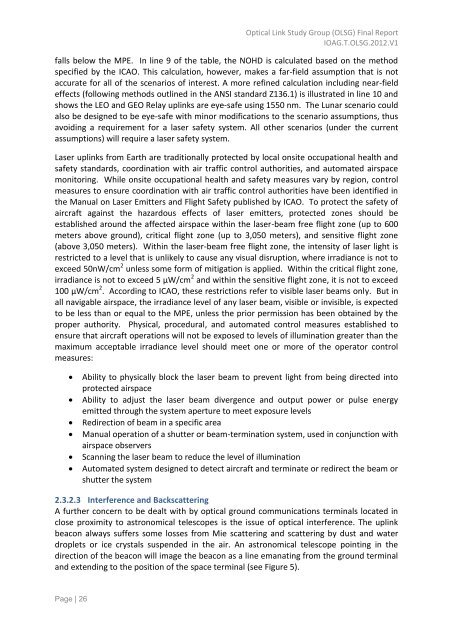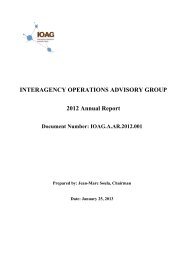OLSG Report_Final_06_05_12 - Interagency Operations Advisory ...
OLSG Report_Final_06_05_12 - Interagency Operations Advisory ...
OLSG Report_Final_06_05_12 - Interagency Operations Advisory ...
You also want an ePaper? Increase the reach of your titles
YUMPU automatically turns print PDFs into web optimized ePapers that Google loves.
Optical Link Study Group (<strong>OLSG</strong>) <strong>Final</strong> <strong>Report</strong><br />
IOAG.T.<strong>OLSG</strong>.20<strong>12</strong>.V1<br />
falls below the MPE. In line 9 of the table, the NOHD is calculated based on the method<br />
specified by the ICAO. This calculation, however, makes a far-field assumption that is not<br />
accurate for all of the scenarios of interest. A more refined calculation including near-field<br />
effects (following methods outlined in the ANSI standard Z136.1) is illustrated in line 10 and<br />
shows the LEO and GEO Relay uplinks are eye-safe using 1550 nm. The Lunar scenario could<br />
also be designed to be eye-safe with minor modifications to the scenario assumptions, thus<br />
avoiding a requirement for a laser safety system. All other scenarios (under the current<br />
assumptions) will require a laser safety system.<br />
Laser uplinks from Earth are traditionally protected by local onsite occupational health and<br />
safety standards, coordination with air traffic control authorities, and automated airspace<br />
monitoring. While onsite occupational health and safety measures vary by region, control<br />
measures to ensure coordination with air traffic control authorities have been identified in<br />
the Manual on Laser Emitters and Flight Safety published by ICAO. To protect the safety of<br />
aircraft against the hazardous effects of laser emitters, protected zones should be<br />
established around the affected airspace within the laser-beam free flight zone (up to 600<br />
meters above ground), critical flight zone (up to 3,<strong>05</strong>0 meters), and sensitive flight zone<br />
(above 3,<strong>05</strong>0 meters). Within the laser-beam free flight zone, the intensity of laser light is<br />
restricted to a level that is unlikely to cause any visual disruption, where irradiance is not to<br />
exceed 50nW/cm 2 unless some form of mitigation is applied. Within the critical flight zone,<br />
irradiance is not to exceed 5 µW/cm 2 and within the sensitive flight zone, it is not to exceed<br />
100 µW/cm 2 . According to ICAO, these restrictions refer to visible laser beams only. But in<br />
all navigable airspace, the irradiance level of any laser beam, visible or invisible, is expected<br />
to be less than or equal to the MPE, unless the prior permission has been obtained by the<br />
proper authority. Physical, procedural, and automated control measures established to<br />
ensure that aircraft operations will not be exposed to levels of illumination greater than the<br />
maximum acceptable irradiance level should meet one or more of the operator control<br />
measures:<br />
<br />
<br />
<br />
<br />
<br />
<br />
Ability to physically block the laser beam to prevent light from being directed into<br />
protected airspace<br />
Ability to adjust the laser beam divergence and output power or pulse energy<br />
emitted through the system aperture to meet exposure levels<br />
Redirection of beam in a specific area<br />
Manual operation of a shutter or beam-termination system, used in conjunction with<br />
airspace observers<br />
Scanning the laser beam to reduce the level of illumination<br />
Automated system designed to detect aircraft and terminate or redirect the beam or<br />
shutter the system<br />
2.3.2.3 Interference and Backscattering<br />
A further concern to be dealt with by optical ground communications terminals located in<br />
close proximity to astronomical telescopes is the issue of optical interference. The uplink<br />
beacon always suffers some losses from Mie scattering and scattering by dust and water<br />
droplets or ice crystals suspended in the air. An astronomical telescope pointing in the<br />
direction of the beacon will image the beacon as a line emanating from the ground terminal<br />
and extending to the position of the space terminal (see Figure 5).<br />
Page | 26



